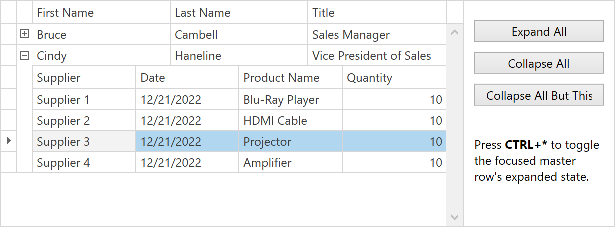GridControl.GetVisibleDetail(Int32) Method
Returns the currently visible detail data control identified by its master row.
Namespace: DevExpress.Xpf.Grid
Assembly: DevExpress.Xpf.Grid.v23.2.dll
NuGet Package: DevExpress.Wpf.Grid.Core
Declaration
Parameters
| Name | Type | Description |
|---|---|---|
| rowHandle | Int32 | An integer value identifying the row by its handle. |
Returns
| Type | Description |
|---|---|
| DataControlBase | A DataControlBase descendant which displays detail data. null (Nothing in Visual Basic) if the currently visible detail is not represented by a DataControlDetailDescriptor. |
Remarks
When you set up a master-detail hierarchy within a GridControl, you create Detail Descriptor objects which contain settings used to create actual detail controls. While there’s a single Detail Descriptor (template) per data relation, there can be multiple detail controls - one per each expanded detail.
The GetVisibleDetail method returns the actual data control that displays detail data for the specified master row. This can be any DataControlBase descendant, but it will typically be a GridControl. Note that the method returns the control only if it’s currently visible (resides within an expanded detail).
Example
This example demonstrates how to expand and collapse the GridControl‘s master rows in code. The example contains the following buttons:
- The Expand All button expands all master rows.
- The Collapse All button collapses all master rows.
- The Collapse All But This button collapses all master rows except for the focused row / row with the focused detail.
The CTRL+* shortcut is bound to toggle the focused master row’s expanded state.

The following table lists members used in this example:
| Member | Description |
|---|---|
| GridControl.CollapseMasterRow | Collapses the detail section for the specified row. |
| GridControl.ExpandMasterRow | Expands the specified master row and, optionally, shows the specified Detail. |
| GridControl.IsMasterRowExpanded | Determines the specified master row’s expanded state and, optionally, the specified Detail’s visibility. |
| GridControl.SetMasterRowExpanded | Changes the expanded state for a specified master row and, optionally, shows a specified Detail. |
<dxg:GridControl x:Name="grid" AutoGenerateColumns="AddNew" Grid.Column="0">
<dxg:GridControl.View>
<dxg:TableView x:Name="view" AutoWidth="True" ShowGroupPanel="False" PreviewKeyDown="TableView_KeyDown"/>
</dxg:GridControl.View>
<dxg:GridControl.DetailDescriptor>
<dxg:DataControlDetailDescriptor ItemsSourcePath="Orders">
<dxg:DataControlDetailDescriptor.DataControl>
<dxg:GridControl AutoGenerateColumns="AddNew">
<dxg:GridControl.View>
<dxg:TableView AutoWidth="True" ShowGroupPanel="False"/>
</dxg:GridControl.View>
</dxg:GridControl>
</dxg:DataControlDetailDescriptor.DataControl>
</dxg:DataControlDetailDescriptor>
</dxg:GridControl.DetailDescriptor>
</dxg:GridControl>
<StackPanel Grid.Column="1" Orientation="Vertical" Margin="10,10,10,10">
<Button Click="ExpandAll" Content="Expand All" Margin="0,10,0,0"/>
<Button Click="CollapseAll" Content="Collapse All" Margin="0,10,0,0"/>
<Button Click="CollapseAllButThis" Content="Collapse All But This" Margin="0,10,0,0"/>
<TextBlock TextWrapping="Wrap" Margin="0,30,0,0">
Press <Bold>CTRL+*</Bold> to toggle the focused master row's expanded state.
</TextBlock>
</StackPanel>
private void TableView_KeyDown(object sender, KeyEventArgs e) {
TableView view = sender as TableView;
// Avoid key processing when focus is within detail views or when a group row is focused:
if (!view.IsFocusedView || view.FocusedRowHandle < 0)
return;
// Process CTRL+* key combination:
if (e.Key == Key.Multiply && ((Keyboard.Modifiers & ModifierKeys.Control) == ModifierKeys.Control)) {
bool finalExpandedState = !view.Grid.IsMasterRowExpanded(view.FocusedRowHandle);
view.Grid.SetMasterRowExpanded(view.FocusedRowHandle, finalExpandedState);
e.Handled = true;
}
}
void ExpandAll(object sender, RoutedEventArgs e) {
for (int i = 0; i < grid.VisibleRowCount; i++) {
var rowHandle = grid.GetRowHandleByVisibleIndex(i);
grid.ExpandMasterRow(rowHandle);
}
}
void CollapseAll(object sender, RoutedEventArgs e) {
for (int i = 0; i < grid.VisibleRowCount; i++) {
var rowHandle = grid.GetRowHandleByVisibleIndex(i);
grid.CollapseMasterRow(rowHandle);
}
}
void CollapseAllButThis(object sender, RoutedEventArgs e) {
for (int i = 0; i < grid.VisibleRowCount; i++) {
var rowHandle = grid.GetRowHandleByVisibleIndex(i);
var detailGrid = grid.GetVisibleDetail(rowHandle);
if (detailGrid != null) {
var detailView = ((GridControl)detailGrid).View;
var focusedDetailRowHandle = ((TableView)detailView).FocusedRowHandle;
if (focusedDetailRowHandle == DataControlBase.InvalidRowHandle && rowHandle != view.FocusedRowHandle)
grid.CollapseMasterRow(rowHandle);
}
}
}